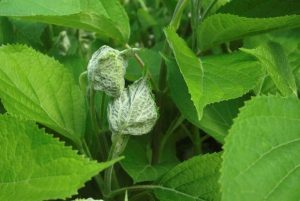
Hello! I have read your three posts on Hydrangea leaftier larva. Thank you for the information. I have been diligent for the last FOUR years, removing the pod like fused leaves from my plants, and cleaning any debris from the soil under plants…… however, the insect keeps returning! Can you please tell me (us) if there is a way to PREVENT this from returning? Can we create an organic spray maybe? Something to add to the soil? Anything that destroys the eggs? My hydrangeas are getting less and less full, with barely any blooms as I am literally deadheading them before they get a chance – they are all infected and glued little pods. I live near the lake in Burlington Ontario. Thank you.
The Hydrangea leaftier (Olethreutes ferriferana) emerges in the spring as a small brown and white patterned moth. The moth then lays eggs on the tips of various hydrangea species. The emerging caterpillars create a protective pocket by “sewing” leaves together and feeding on the enclosed flower bud and surrounding leaves. In summer, the larvae drop to the ground pupate over winter, and emerge as adult moths the following spring.
It sounds like you are doing all the right things to mechanically control these pests. While leaftier typically don’t cause any permanent damage to plants, left uncontrolled their impact can be unsightly, and will reduce the number of blooms. If you want to protect the blooms, rather than clipping out the leaf pockets, you can open them up as soon as they emerge, and remove the caterpillars, either squishing them or dropping them in soapy water to kill them. If you are quick enough, you may preserve the flower bud if the caterpillars’ feeding has not been too extensive.
Finally, you can consider applying Bacillus thuringiensis kurstaki (Btk), a naturally occurring bacteria that will attack the gut of the caterpillars leading to an infection that kills the insect. Btk is generally considered to be effective, selective and safe. You can find Btk at a reputable garden centre. Be sure to follow the manufacturers directions for application. However, Btk will only be effective when the caterpillars first emerge, but before they create their protective pockets, so it will need to be applied in early spring.

